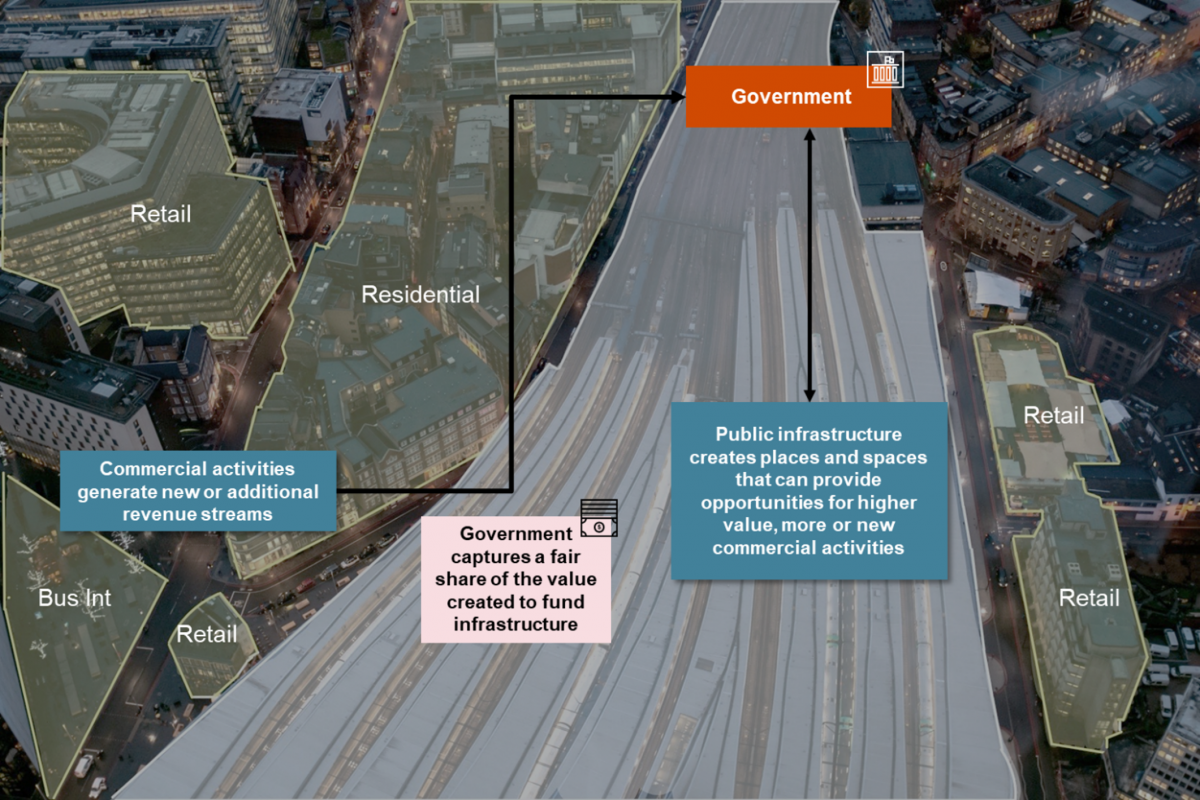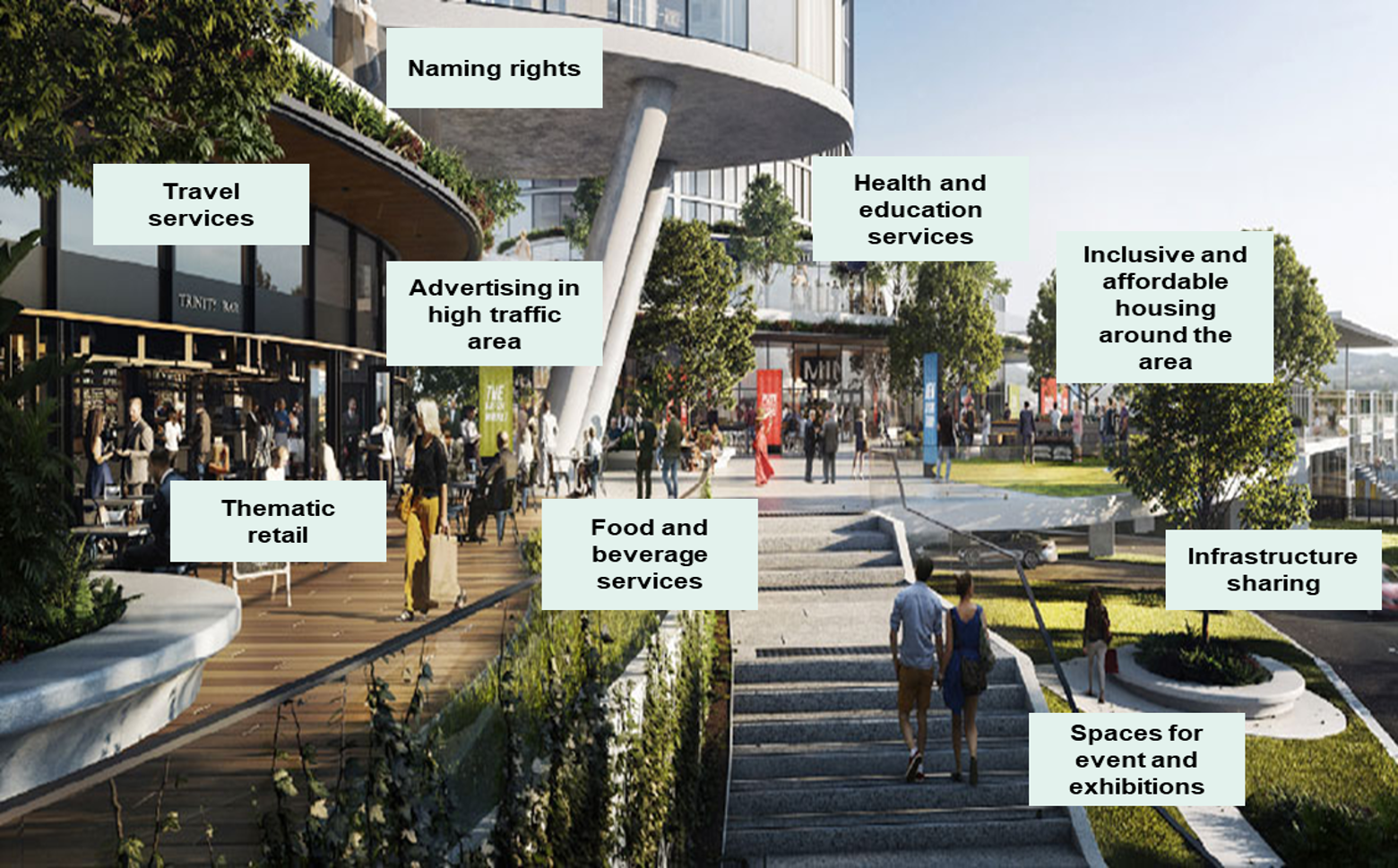What is Commercial Value Capture (CVC)?

Photo Credit: Image by Pixabay
On this page: Find the role and potential of Innovative Revenues for Infrastructure and Commercial Value Capture in closing the funding gap as well as sectors in which CVC can be applied. Check the Innovative Revenues for Infrastructure section or visit the Content Outline.
Public infrastructure often creates places and spaces that provide opportunities for more, higher value and new commercial activities that generate additional revenue.1 Most often, it is the private sector that takes advantage of these opportunities and disproportionately profits from them. However, where government makes the investment that creates the places and spaces where commercial activities can occur, it should capture a fair share of the revenue created to fund the infrastructure that creates this value. Figure 2: CVC Concept CVC can be a way for governments to increase revenues to fund facility improvements, expand services and/or asset maintenance without increasing fiscal liabilities or user fees. Governments can apply a comprehensive planning approach that creates commercially driven demand for integrated solutions by identifying the broader needs of users and beneficiaries as illustrated in Figure 3. Figure 3: Examples of commercial activities for an urban transit-oriented development project CVC can provide financial and non-financial benefits to a project. While one of the main objectives of CVC is to help reduce the funding gap and improve financial viability of the project, CVC can also generate important non-financial benefits to the project. CVC can help address community needs by providing economic growth, jobs, diversification of commercial development, improved property values, and improved infrastructure user experience (which may increase demand). CVC can help revitalize a dilapidated neighbourhood, repurpose outdated cultural assets, and improve access to basic urban services such as low-income housing. It is important to take a comprehensive view of CVC and consider commercial, economic and social opportunities. Although CVC is most common and well-established in urban transit (sometimes popularly known as ‘transit-oriented development’), it is relevant for a number of sectors including urban services, public housing, government offices, hospitals, schools, libraries, stadiums, street lighting, parking facilities, airports, telecom services, urban renewal projects, parks, wastewater treatment, solid waste treatment and conservation areas. CVC opportunity is not confined to a specific sector but depends on project characteristics and the Project Owner’s creativity in developing integrated solutions. For example, there are several CVC opportunities that can be considered in a wastewater project (See Worked Example 1 in Annex 1), such as sale of reclaimed water, sale of carbon credits, sale of biogas and electricity, sale of phosphorus as fertilisers, sale of biosolids as compost, etc. Figure 4 shows some of the key sectors in which CVC can be adopted and Table 1 provides examples for reference. However, these are by no means an exhaustive list. Figure 4: Sectors in which CVC can be applied (non-exhaustive list) Table 1: Examples of projects in which CVC have been adopted for reference The Municipal Public-Private Partnership Framework - Project Summaries - Part 2 - Education The Municipal Public-Private Partnership Framework - Project Summaries - Part 2 - Healthcare The Municipal Public-Private Partnership Framework - Project Summaries - The Municipal Public-Private Partnership Framework - Project Summaries - Part 2 - Affordable Housing The Municipal Public-Private Partnership Framework - Project Summaries - Part 2 - Energy Footnote 1: Module 17 – Capturing Commercial Value of the World Bank Municipal PPP Framework.



Sector
Example
Source
Rail
Hong Kong Mass Transit Railway Corporation, Hong Kong SAR, China
School
Bundled Schools, Ireland
Hospital
Hemodialysis Center at the National Kidney and Transplant Institute, Quezon City, Manila, Philippines
Stadium
Sports Hub, Singapore
Affordable Housing
Regent Park Affordable Housing Project, Toronto, Canada
Street Lighting
Street Lighting Project, Nasik, Maharashtra, India
The Guidelines on Innovative Revenues for Infrastructure (IRI) is intended to be a living document and will be reviewed at regular intervals. They have not been prepared with any specific transaction in mind and are meant to serve only as general guidance. It is therefore critical that the Guidelines be reviewed and adapted for specific transactions.
To find more, visit the Innovative Revenues for Infrastructure section and the Content Outline, or Download the Full Report. For feedback on the content of this section of the website or suggestions for links or materials that could be included, please contact the Public-Private Partnership Resource Center at ppp@worldbank.org.
Updated:
TABLE OF CONTENTS
I. Innovative Revenues for Infrastructure (IRI)
2. Introduction to Commercial Value Capture (CVC)
• Maximizing Revenue for Funding Infrastructure
• CVC Opportunities in Infrastructure
• Core Principles in Applying CVC in Projects
3. Applying CVC in Infrastructure Projects
3. Recommendations in Drafting ToRs with CVC
Related Content
Additional Resources
Climate-Smart PPPs
Type of ResourceFinance Structures for PPP
Type of ResourceFinancing and Risk Mitigation
Type of Resource